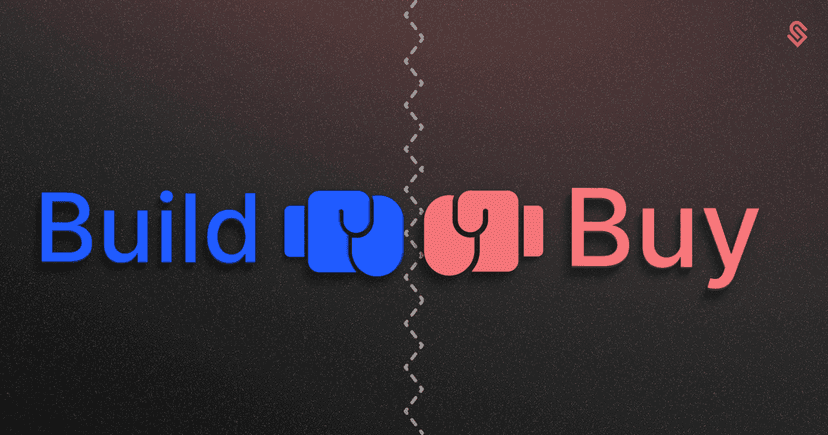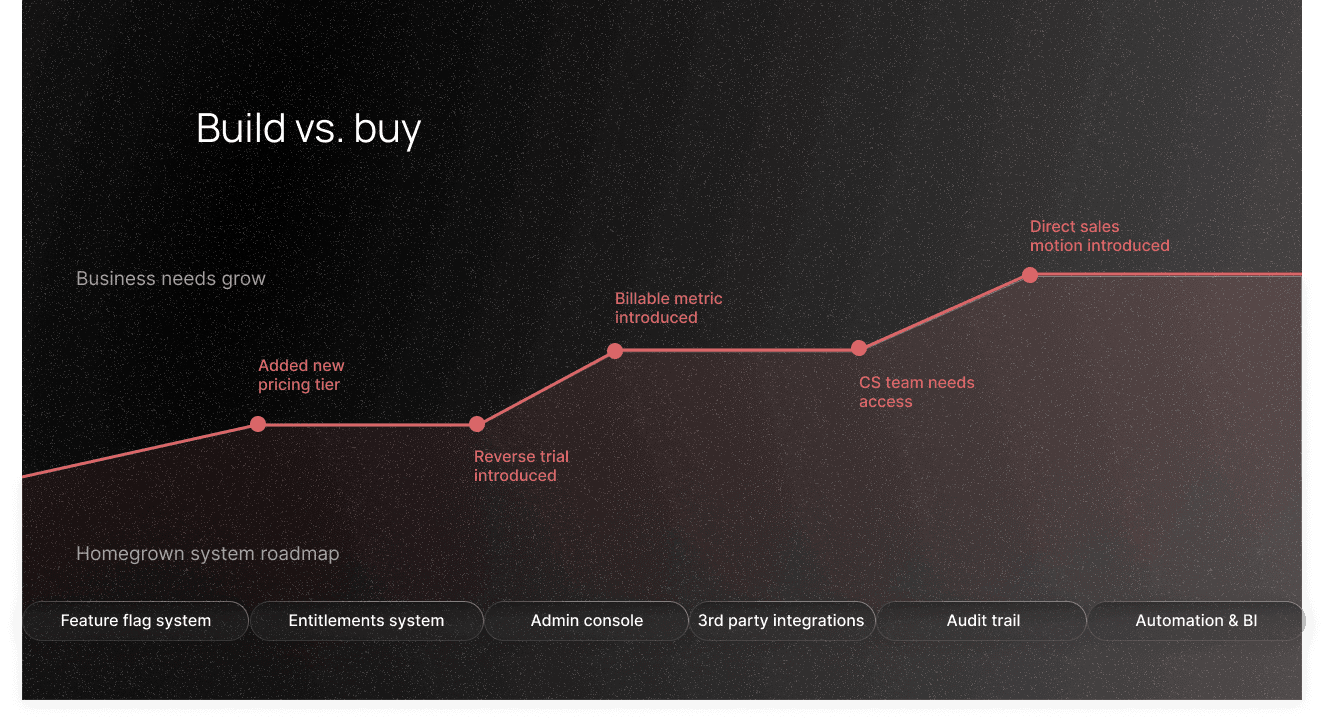

Billing automation is one of those "good problems" to have. It may not be on the launch list for most startups. But, if you're lucky, revenue takes off. Then, billing can quickly emerge as a problem.
I was just on a call with a startup that grew to 30K MRR within two months. Their manual billing processes were barely working. They were relying on manual intervention for everything from payment collection to customer payment history. The entire billing process was taking too much time compared to everything else they needed to do.
It was great that they were crushing growth. However, billing automation was still a problem.
We see this pattern repeat across fast-growing B2B SaaS companies - every week spent on a "simple" billing automation project means more engineering talent is wasted on payment fixes (missed charges, revenue leakage, and billing errors). Without proper infrastructure, these problems compound with each new customer revealing their true cost: untangling billing complexities are happening at the expense of building the features that could drive growth. Getting stuck with hard-coding billing logic, managing entitlements in Stripe metadata, and building custom feature flag systems just to handle basic plan changes can demoralize a team. When competitors with flexible billing systems are launching new pricing options and are adapting to market demand.
For some startups, billing is simple. For others, billing can be the iceberg of engineering projects. Here's what's hiding beneath the surface (from those who learned the hard way).
When technical founders first evaluate automated billing software, they often underestimate the full scope of what needs to be built. One founder we spoke with described their proof-of-concept for handling billing operations using basic payment methods as feeling "gross and shoehorned." It pretty well sums up a broader reality: automated systems for billing are far more complex than they initially appear.

What starts as "just billing" quickly evolves into complex interconnected systems. To drive home what "just billing" could become, here's a non-comprehensive list of what engineering teams might end up building:
Most teams start here, building a simple system to toggle features on and off. It seems straightforward – just a database table mapping features to customers. But when you add that new pricing tier, you suddenly need a bit more logic to handle different feature combinations across customer segments. Kill switches also become useful for mitigating risks, enabling teams to disable features instantly if something goes wrong or there's nefarious usage of the product. If you want to go deeper, check out our post on why most companies struggle with feature flag entitlements.
As businesses grow, managing who gets access to which features becomes increasingly complex. Teams find themselves building systems to enforce entitlement policy based on subscription status and other company attributes. This often involves setting up rules for tiered access, metering usage, and managing exceptions for specific customers. These systems are critical for aligning feature availability with billing, but they can quickly become a tangled web of custom logic.
To support business stakeholders, teams frequently build admin consoles that allow others to manage features, plans, and customer config. These tools often grow to include capabilities like beta groups, running A/B tests, or introducing feature trials. While these tools are essential to manage growing customer bases, they require significant time and effort to build. See our guide on building monitoring dashboards
Supporting more sophisticated selling motions often require integration with third-party tools. For example, the product might need to leverage context from the billing systems, the CRM, and customer support software. Building these integrations in-house means not only implementing the initial connections but maintaining them as APIs evolve and new tools enter the workflow. Teams frequently underestimate the ongoing work required to keep these integrations running smoothly and handling edge cases across different platforms.
Unifying account-level data and billing data is the foundation for product usage analysis and financial planning. Over time, this matures into predictive analytics that help businesses anticipate customer behavior, optimize pricing, and proactively engage high-value accounts. Developing analytics capabilities from scratch requires significant investment in data infrastructure, visualization tools, and maintaining data accuracy across systems - resources that could otherwise be spent on core product.
Finally, as the product and processes around it mature, engineers often need to build ways to handle automated provisioning, customer migrations, and manage exceptions like legacy customers to reduce humans in the loop, decrease time to value, and increase precision. The complexity of these automation systems compounds with each new use case, requiring robust error handling, rollback, and audit trails.
This reflects what we see in the market: what starts as "just billing" inevitably grows into a sophisticated platform that must handle increasingly complex business requirements. What might start as a simple feature flag system can quickly turn into a complex entitlements management platform requiring dedicated engineering resources to maintain and extend. Each step change in business needs – from adding pricing tiers to introducing direct sales – triggers a corresponding need for technical sophistication that many homegrown systems struggle to achieve.
CTOs for small teams don't want their engineering teams forced into constant billing workflow updates. Otherwise they find their team regularly revising pricing models to match market demands, implementing exceptions for specific customers who need custom arrangements, and integrating new features into the billing system. It's work that is valuable to the business, so that's why so many startups end up adding these kinds of updates to their backlogs.
The work doesn't stop there – teams must fine-tune usage calculations and handle a growing array of edge cases in payment processing. As one solo founder of an AI company put it simply: "We need an effective automated billing system without diverting engineering resources from core features." This captures the heart of the challenge: it's not just about building these components initially—it's about the ongoing maintenance they require as your business evolves.
The true cost of building a billing solution goes far beyond initial development. A CTO who had previously built similar billing software shared their experience: "At my last company, we spent months building what we thought would be a simple automated billing system. Two years later, we still had two engineers dedicated to maintaining it and eliminating manual processes."
From our experience and what we've seen firsthand, here's what that maintenance typically involves:
Initial Development: 3-6 months of engineering time for basic billing operations
Ongoing Maintenance: 1-2 engineers dedicated to billing workflows
Feature Requests: Regular updates for new payment methods and business requirements
Technical Debt: Growing complexity as custom automated billing work accumulates
The hidden cost isn't just the time spent building billing software—it's the core product features that don't get built. For fast-growing companies, this opportunity cost can be substantial.
When engineering resources are diverted, it means you're delaying releases that make your product differentiated. It also means startups are unable to quickly test new pricing models or respond to market demands, which slows the path to PMF and growth.
The solution isn't just about automating billing. The most effective approaches treat billing as an extension of feature management, not as a separate infrastructure challenge. This unified approach makes sense because every paid feature requires both feature logic and billing logic to work properly - when these systems are separate, you create duplicate logic that must stay perfectly synchronized.
When technical founders modernize their billing approach, they often discover that the biggest wins come from unifying feature management and billing into a single system.
This unified approach means entitlements become configuration rather than code, eliminating the technical debt that accumulates from hard-coded billing logic. Schematic's unified approach means startups are able to stop storing entitlements in Stripe metadata and building custom feature flag logic. Then business teams can modify pricing and packaging without touching production code, which changes how startups approach monetization.
The reality is that most early-stage B2B SaaS companies face three critical challenges with traditional billing approaches:
Engineering teams spend valuable time maintaining billing code instead of building core features
Business teams can't experiment with pricing without engineering support
Customer-specific requirements lead to mounting technical debt
Modern billing platforms solve these challenges by treating billing as a feature management problem, not just a payment processing one. This is a perspective shift—when billing logic lives in your configuration rather than your code, you get flexibility without tech debt. We separate billing from code at Schematic through a dedicated feature management layer that sits between your product and Stripe. Instead of spending sprints building customer portals for subscription management or usage tracking, engineering teams can focus on their core product while embedding pre-built components for the billing experience. Tasks that historically required custom code, like handling customer-specific pricing or entitlements, become simple configuration changes.
Rather than replacing existing systems, this approach builds upon them. We designed our platform to work seamlessly with your existing Stripe setup while extending its capabilities through a dedicated feature management layer. By separating billing logic from application code, you get fast, reliable entitlement checks that work across distributed systems without compromising your architecture. Most importantly, you maintain clean integration points through well-designed APIs and SDKs, ensuring your engineering team stays focused on what makes your product unique.
Why spend your engineering expertise on billing software when you could be building your core product? Companies like Automox and Makeswift learned this firsthand - they found that eliminating "commercial debt" from manual billing processes freed their engineering teams to focus on core product innovation. As one successful founder advised: "Evaluate the true cost of manual billing processes. It's not just about the initial build—it's about the ongoing maintenance and the features you won't build while managing payments."
Consider these questions when evaluating your billing automation strategy:
How much engineering time are you currently spending on billing operations?
What core features could you build with those resources?
Can your current billing system scale with your business?
As engineers, we should be building core features that make our products unique, not reinventing billing infrastructure. Every hour spent maintaining custom billing code is an hour not spent on the challenging technical problems that actually differentiate your product. Modern billing automation makes this possible, allowing you to implement sophisticated pricing models without diverting engineering resources from what matters most: your product.